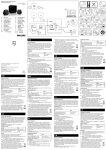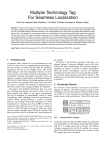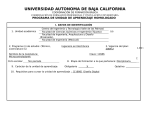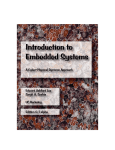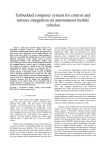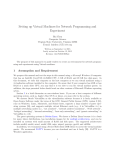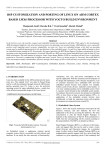Download Untitled - Universiti Teknologi Malaysia
Transcript
i DATA TRANSMISSION SYSTEM OF REFM NETWORK USING PIC MICROCONTROLLER AND GSM MODULE MOOK BOON KEAN A thesis submitted in partial fulfillment of the requirements for the award of the degree of Bachelor of Engineering (Electrical) Faculty of Electrical Engineering University Teknologi Malaysia JUNE, 2012 ii I declare that this thesis entitled “Data Transmission System for REFM Network using PIC Microcontroller and GSM Module” is the result of my own research except as cited in references. This thesis has not been accepted for any degree and submitted in candidature of any other degree. Signature : ………………………… Name : MOOK BOON KEAN Date : 1 JUNE 2012 iii Specially dedicated to my beloved father and mother Mook Lai King and Lee Siew Foong brothers and all my friends, for their encouragement, support and inspiration throughout my education journey iv ACKNOWLEDGEMENT First and foremost, I would like to take this opportunity to express my heartily appreciation to my supervisor, Dr. Muhammad Abu Bakar b. Sidik. I am deeply indebted to my supervisor for the guidance and enthusiasm given throughout the progress of this project. At the outset, I would like to express my gratitude to my family especially my parents who has been so tolerant and supports me throughout my study in Universiti Teknologi Malaysia. Thanks for their encouragement, love and emotional supports that they had given to me. Nevertheless, my great appreciation is dedicated to Faculty of Electrical Engineering, UTM for the support given throughout the project. Besides, I would like to thank my friends and individuals whom involve directly or indirectly with this project. There is no such meaningful word than. Thank You So Much. v ABSTRACT Data transmission is a crucial part of every system, as the method of data transmission can affect the efficiency of the system. Different methods of data transmission will be fit in to different application due to the range of transmission and losses factor suffered by the transmission method. Data transmission can be divided into two categories which are wired and wireless. This project presents a research on the data transmission of the REFM network through a hardware group and program modules. The main function of the proposed system is to transfer data between sensor and PC wirelessly. For this purpose, PIC16F877A microcontroller will be used as the central processing of the project and SIM300 GSM module is used to send the information from REFM sensor via GPRS function. Then the data collected will be store in an online database, MySQL for monitoring and analyzing purpose. vi ABSTRAK Penghantaran data adalah bahagian yang amat penting dalam setiap sistem, kaedah penghantaran data boleh menjejaskan kecekapan sesebuah sistem. Kaedah penghantaran data yang berbeza akan diguna untuk aplikasi sistem yang berbeza kerana linkungan penghantaran dan faktor kehilangan data yang dialami akan diambil kira. Penghantaran data boleh dibahagikan kepada dua kategori iaitu berwayar dan tanpa wayar. Projek ini membentangkan kajian mengenai penghantaran data untuk rangkaian REFM melalui satu kumpulan perkakasan elektronik dan modul program. Fungsi utama sistem yang dicadangkan adalah untuk memindahkan data antara sensor dan PC secara wayarles. Untuk tujuan ini, mikropengawal PIC 16F877A akan digunakan sebagai pusat pemprosesan projek dan SIM300 GSM modul akan digunakan untuk menghantar maklumat daripada sensor REFM melalui fungsi GPRS. Kemudian data yang dikumpul akan disimpan dalam pangkalan data dalam talian, MySQL untuk memudahkan proses pemantauan dan penganalisis. . vii TABLE OF CONTENTS CHAPTER 1 2 TITLE PAGE DECLARATION OF THESIS ii ACKNOWLEDGEMENT iv ABSTRACT v ABSTRAK vi TABLE OF CONTENT vii LIST OF TABLE xi LIST OF FIGURE xii LIST OF SYMBOLS xiv LIST OF ABBREVATION xv LIST OF APPENDICES xvii INTRODUCTION 1 1.1 Background 1 1.2 Problem Statements 2 1.3 Research Objectives 3 1.4 Scopes 3 1.5 Outline of Thesis 4 LITERATURE REVIEW 5 2.1 Introduction 5 2.2 Lightning Strike Phenomenon 5 2.2.1 Mechanism of Lightning Strikes 6 Rotating Electric Field Mill 8 2.3 viii 2.4 Data Transmission 8 2.4.1 Global System for Mobile 9 Communication, GSM 2.4.2 General Packet Radio Service, GPRS 10 2.5 Online Database, MySQL 10 2.6 Communications Architectures and Protocols 11 2.6.1 Open Systems Interconnection (OSI) 11 Model 2.7 Review of Previous Research 12 2.7.1 Wireless Data Transmission Between 12 Personal Computers 2.7.2 Wireless Data Acquisition System for 13 Remote Care of Newly Born Prematures 3 METHODOLOGY 15 3.1 Introduction 15 3.2 System Design of Data Transmission System of 15 EFM Network Using PIC Microcontroller and GSM Module 3.3 Hardware Design 16 3.3.1 Peripheral Interface Controller (PIC) 17 Microcontroller 3.3.1.1 Oscillator 20 3.3.1.2 Reset (MCLR) 21 3.3.1.3 Analog to Digital Converter 22 (ADC) 3.3.1.4 Serial Communication Interface (SCI) 22 ix 3.3.2 SK40C Development Board 24 3.3.3 Serial Communication 24 3.3.3.1 MAX 232 Integrated Circuit 25 3.3.4 Serial Liquid Crystal Display, LCD 26 3.3.5 MOD 9001D RS232 GSM/GPRS 27 Module 3.4 4 Software Design 28 3.4.1 MPLAB IDE, HITECH C and PICkit2 28 3.4.2 AT Commands 30 3.4.3 PIC Microcontroller Program Flow 31 3.4.4 Online Database, MySQL 33 TESTING, RESULTS AND DICUSSION 35 4.1 Introduction 35 4.2 Testing 35 4.2.1 Tests with Random Value 35 4.2.1.1 Procedures 35 4.2.1.2 Result 36 4.2.2 Tests with Function Generator 5 37 4.2.2.1 Procedures 37 4.2.2.2 Result 38 4.3 Software Results 39 4.4 Discussions 40 CONCLUSION AND RECOMMENDATIONS 42 5.1 Introduction 42 5.2 Conclusion 42 x 5.3 REFERANCE APPENDICES A-D Recommendations 43 44 46-60 xi LIST OF TABLE TABLE NO. TITLE PAGE Table 3.1 Part of PIC16F877A Device Features 19 Table 3.2 Baud Rate Formula 23 Table 3.3 Voltage Range of RS232 and TTL 25 Table 3.4 Part of AT Commands Set for Data Transmission 31 xii LIST OF FIGURE FIGURE NO. TITLE PAGE Figure 2.1 Types of Lightning Strike 6 Figure 2.2 Main and Return Stroke Development 7 Figure 2.3 Electric Field Strength Variations 7 Figure 2.4 Rotating Electric Field Mill 8 Figure 2.5 OSI Models 12 Figure 3.1 Block Diagram of the Proposed System 15 Figure 3.2 Schematic of the Hardware Design 17 Figure 3.3 PIC Microcontroller 17 Figure 3.4 PIC16F877A 18 Figure 3.5 Pin Diagram of PIC16F877A 19 Figure 3.6 Flowchart of Programming a Microcontroller 20 Figure 3.7 Crystal Resonator Operations for LP, XT, HS Mode 21 Figure 3.8 SK40C Development Board 24 Figure 3.9 MAX232 Integrated Circuit 25 Figure 3.10 Pin Diagram of MAX232 Integrated Circuit 26 Figure 3.11 Serial LCD 26 Figure 3.12 MOD 9001D RS232 GSM/GPRS Module 27 Figure 3.13 Algorithms for Programming PIC Microcontroller 30 Figure 3.14 Program Flow for Microcontroller 32 Figure 3.15 MySQL Database Control Panel 33 Figure 3.16 PHP Language Access Diagram 34 xiii Figure 4.1 Output of the Random Value Test Showed on Web 36 Server Figure 4.2 Output of the Function Generator Test Showed on Web 38 Server Figure 4.3 Systems with Feedback to the Computer 38 Figure 4.4 Hardware Completed in Box 39 Figure 4.5 Programmer’s Output 39 Figure 4.6 Compiler’s Output 40 xiv LIST OF SYMBOLS DEFINITION SYMBOL. Hz Hertz M meter M Mega V Volt I Current k Kilo P Pico F Farad Fosc Oscillation frequency 2G Second-generation xv LIST OF ABBREVATION DEFINITION SYMBOL. EFM Electric Field Mill REFM Rotating Electric Field Mill GSM Global System for Mobile Communication GPRS General Packet Radio Service RDBMS Relational Database Management System SQL Structured Query Language IDE Integrated Development Environment ADC Analog to Digital Converter AT Attention PHP Hypertext Prepocessor TTL Transistor – Transistor Logic MSC Mobile Switching Center TDMA Time-Division Multiple Access CDMA Code-Division Multiple Access SMS Short Messaging Service PPP Point-to-Point Protocol IP Internet Protocol OSI Open System Interconnection PIC Peripheral Integrated Circuit RF Radio Frequency CMOS Complementary-Metal-Oxide-Semiconductor PC Personal Computer I/O ports Input and Output ports xvi USART Universal Synchronous Asynchronous Receiver Transmitter WAP Wireless Application Protocol ROM Read Only Memory RAM Random Access Memory EEPROM Electrical Erasable Programmable Read Only Memory MCLR Master Clear POR Power-on Reset SCI Serial Communication Interface SPEN Serial Port Enable BRGH High Baud Rate Select LCD Liquid Crystal Display SPI Serial Peripheral Interface TCP Transmission Control Protocol HTML Hyper Text Markup Language xvii LIST OF APPENDICES APPENDIX. TITLE PAGE A PIC16F877A Datasheet 46-52 B SK40C Development Board User Manual 53-55 C MAX232 IC Datasheet 56-57 D Serial LCD User Manual 58-60 1 CHAPTER 1 INTRODUCTION Chapter one introduces the project description which includes the background of the project, problem statements, objectives, scopes and the outline of the thesis. 1.1 Background Atmospheric electric field detection is very crucial for area with high rate of lightning occurrence. Atmospheric electric field detection is very useful in detecting the atmospheric conditions at surroundings; thereby knowing when the lightning is occurring. By predicting the lightning strike occurrence, warning can be send out to alert the people at the particular area, so that they are able to avoid walking in the outdoor areas which is exposed to lightning strike or take shelter in time. In addition, there are lack of atmospheric electric field detection systems are installed in highly congested areas, such as parks and recreation or cities and municipalities; therefore it is difficult to evacuate the crowd. The detection system is able to detect the atmospheric condition and help in evacuating the crowd efficiently. Previously, there are many atmospheric electric field detection equipment had been invented. As in the era of science and technology, there are rapid growths of the industry, there is a need in system which able to deliver accurate result in a short interval. In the same time, the method of sending alert to end user is crucial factor of the effectiveness of the system. Furthermore, most of the systems available do not possess the ability to store the collected data and conventional method of data storing is 2 inefficient and involving plenty of handwriting. For many type of applications, data storing is essential for future reference and research. 1.2 Problem Statements In the market, there are numerous advanced atmospheric electric field detection systems, but the tradeoff for the highly sensitivity and powerful equipment, the cost of the system will be very high. Furthermore, most of the highly sensitivity and powerful equipment required sophisticated setup, test and extra precaution to be considered. All these may result in inconvenience for the users. From all of the available advanced atmospheric electric field detection systems, most are using rotating electric fill mill, REFM as their sensors as it is a specialized instrument used for atmospheric electric field measurement. Most of the systems, the main problem faced is the connection between the sensors with the end users. Conventional method of the connection to the end user is by using wired transmission, but the cost for the cable will be very high if the distance between sensor and end user is far. Then the development of the wireless industry leads to the improvement of REFM network which overcome the problem of wired connection. However, the transmitting devices that used for REFM network currently are discouraging as the range of device is limited in a very short range. Therefore, it is very inconvenience if end users or main server located far from the sensors. Other than that, for long range transmission of data, the losses of transmission must be considered. High losses will cause the efficiency of the system to drop drastically and result in inaccurate prediction and data collection. Therefore, the choice of data format for transmission must be considered as to decrease this problem. In most cases, we are not only acquiring the values from the REFM sensor and direct it to users, but we have to store the data constantly as well. Data storing is essential, as the data stored can be as reference for future improvement of the systems as well as to be used for research purpose. Furthermore, data stored will be analyzed before 3 the alert sent to the users; this will reduce the false alert occurrence and increase the accuracy of the system. 1.3 Research Objectives The first objective of this project is to provide a solution which is cost effective on collection of data from sensor located at remote area, identifying the suitable hardware and software to be used in the project. The second objective of this project is to transmit data from sensor by using long range wireless connection. GSM module which offering both GSM and GPRS with worldwide coverage will perform the long range transmission. The third objective of this project is to reduce the losses suffered from long range transmission. By converting the analog data collected from sensor to digital data for transmission by using PIC microcontroller. The fourth objective of this project is to receive and store data for analysis. Online database, MySQL will be personalized so that the data will be stored and is set to restrict to only authorized personnel are able to get access to data for further analysis. 1.4 Scopes These scopes are to ensure the project is conducted within its boundary of software and hardware design and the final product achieves its intended objectives. The following are the scopes of design: Write a program using C language with the Integrated Development Environment (IDE) of the project, MPLAB version 8.46 to set the peripheral functions such as Analog to Digital conversion and timer of PIC microcontroller. 4 Use C programming to send AT commands to the GSM module and response to the reply from the GSM module, so that the wireless connection commenced. Write a program using Hypertext Preprocessor, PHP for the online database, MySQL, for online data storage. Design a voltage driver circuit with MAX232 integrated circuit, for interfacing serial port of GSM module and TTL logic device, PIC microcontroller. Implement of designed circuit system to hardware and feedback the hardware output to PC for monitoring purpose. 1.5 Outline of Thesis This thesis consists of five chapters. In first chapter, it focuses on the main ideas of the project, mainly about the problem statements, objectives and scopes of this project. While Chapter two will discuss more on theory and literature reviews that have been done. It will discuss about the studies that are related to this project. Information was retrieved via books, journal, online sources and articles. In Chapter three, the discussion will be on the methodology to conduct this project. Hardware and software design of the entire project will be discussed which include the methods and techniques used in the circuit design, programming and others. In Chapter four, the testing, results and the discussion will be included. Lastly, Chapter five will be the summary for this thesis and recommendations suggested for improvement on this design and for further research related to this topic. 5 Chapter 2 LITERATURE REVIEW 2.1 Introduction Chapter two explains about the literature review on the studies that are related to this project. Literature review provides guidelines and information that are essential for the project completion. Information was obtained through books, journals, articles and online sources. 2.2 Lightning Strike Phenomenon Lightning strike represented as one of the most important causes of deaths, injuries and property damage from environmental phenomena. A peak discharge in which charge accumulated in the clouds discharges into neighboring cloud or to the ground is the lightning phenomenon [1]. However, the factors which contribute to the charge accumulation in the clouds are many and uncertain. There are three main types of cloud discharge which normally occurred, as showed in Figure 2.1. a) Within cloud b) Cloud-to-ground c) Cloud-to-cloud 6 Figure 2.1 Types of Lightning Strike Malaysia, a country with high atmospheric humidity and solar heating, result in higher lightning strike density. Kuala Lumpur, the country capital city is ranked fifth in the world with its high lightning strike density [2]. In addition, a typical lightning strike is able to last more than one second, and plenty of discharges occurred within the second [1]. 2.2.1 Mechanism of Lightning Strikes The charge density of the clouds increased will result in the increase of surrounding electric field. When the electric field intensity exceeds the insulation strength of a portion of the moist ionized air, air breakdown will occurred. The surrounding air will transform into a conductor allowing charge to transfer, and then an electric streamer will be formed from the clouds to the earth with 1/10 of the speed of light. The streamer will progress about distance of 50 m before the light or bright flash emitted [1]. A lightning strike and electrical discharges consists of few separate discharges started from leader discharge, then main and return stroke discharges. Stepped leader is streamer repeating its performance and it is not the actual lightning strike but it provides 7 the channels between cloud and earth which the electrons travel during discharge. As the electron from step leader approach the ground, positive charges accumulated under the leader core. This give rise to the electric field intensity on the ground and build up the path. The return stroke follows when the leader touched the ground, then large current will flow through the path. This will heats the surrounding air causing it to expand and creates a shockwave which we observe as lightning [1]. Development of the main or return stroke is as showed in Figure 2.2. Figure 2.2 Main and Return Stroke Development [1] During the lightning strike, both electrical and magnetic induction will occur even in significant distance from the strike location [3]. Magnetic coupling from lightning strike can induce high voltage surge to conductor and cause damage. While the electric fields generated before lightning strike can go up to approximately 500kV/m within 100m range of strike [4]. The electric field induced (Figure 2.3) is measured within distance of 100m from the lightning strike to ground. Figure 2.3 Electric Field Strength Variations [5]. 8 2.3 Rotating Electric Field Mill Rotating Electric Field Mill is an electro-mechanical device which measures the relative strength of an electric static field by comparing the reference level of electric field. There is a sensor plate in the device, when it is exposed to the electric field, the uncharged plate will be charged. Two main processes occurred in the field mill, which are exposing and shielding. Exposing is to expose the sensor plate to atmosphere so that it will be charge, while shielding will be discharge of the sensor plate. These processes are controlled by a motor-driven rotor and stator arrangement which will open and close alternately, as showed in Figure 2.4 [6]. By comparing with reference, the rate and level of the sensor plate changing will be determined and whenever there is excessive electric field density, lightning strike will most likely occurred, it will be predicted and safety precaution may be done in time. Figure 2.4 Rotating Electric Field Mill [21] 2.4 Data Transmission Data transmission has played an important role in the advancement of mankind, as it is utilized in computer buses for communication with peripheral equipment. Data transmission can be defined as the physical transfer of data over a point-to-point or point-to-multiple communication channel. There are various types of channels available for data transmission, for example wires made of copper or fiber-optics. Each of it has 9 been use for different type of applications. In the market, there are mainly two types of data transmission channels, which are wired and wireless. Wireless transmission is the transfer of data between two or more points which the channels are not physically connected [7].The range of the wireless transmission can be either short or long depends on the device used. And it is mainly used to overcome situations where normal cabling is difficult or financially impractical. Wireless networks are divided into two categories based on how it is constructed. First, the infrastructurebased network which a network is having preconstructed infrastructure that is made of fixed network structure. For example, cellular network that built from back-bone switches, mobile switching centers (MSCs), base stations and mobile hosts. Second, the infrastructureless network which a network is formed dynamically through a collective of random set of independent wireless devices. For example, a mobile ad hoc networks which connect several wireless devices [7]. 2.4.1 Global System for Mobile Communication, GSM GSM is the second-generation (2G) systems that use digital multiple-access technology, such as time-division multiple access, TDMA and code-division multiple access, CDMA. In the previous generation which is the first generation systems are using analog radio signal. Up until today, GSM network is popular, since cellular phone is still using this network, as the protocol of 2G networks support the voice and some limited data communications, such as faxing and short messaging services (SMSs) [7]; Thus, it is on the market for a long time and now it is offering varieties of features and having users of more than 5 billion people, more than 80% of earth population [8] [9]. In addition, GSM is offering low cost ownership and worldwide coverage as this technology has been existed for more than 20 years [9]. However, GSM has several shortcomings, which it is unable to perform transmitting and receiving data concurrently and the unsatisfactory real-time ability [10]. 10 2.4.2 General Packet Radio Service, GPRS With the shortcoming of the 2G network, then it further develop into 2.5G, which is the GPRS network. GPRS is a packet data technology based on GSM that support both Point-to-Point Protocol, PPP and Internet Protocol, IP, it provide a shorter time for internet service provider connections and the charging will be based on amount of data sent instead of connection time. With the added packet-switching protocols, it will break the voice or data information into packets which only few kilobytes each. Then based on addressing data within packet, the information will be routed by network between different destinations. As compare to GSM, GPRS has high transmission rate, ability to transfer real-time data, supporting internet protocol, IP and having the ability to access the internet [7]. 2.5 Online Database, MySQL A database is mainly separated into two main components. First is the server-side tool that includes database system such as MySQL or Oracle, which is the core software engine that runs functions like creating, optimizing and managing databases, executing queries and maintains database security. Second is the client-side tool that is the database client like PHP script or a program written in C language, which function to manage the import and export of utilities from databases [11][12]. MySQL AB, a company which is based in Sweden has created and supported MySQL database since year 1979, where SQL is the Structured Query Language. MySQL is developed based on three fundamental principles, which are ease of use, reliability and performance [12]. MySQL had been developed as a relational database management system (RDBMS) based on the principles. A RDBMS allows the combination of data from multiple Tables and enhancing the vision by storing the data more efficiently and removing the repetition; thus reduce the overall time took to execute the queries and return results to the caller [11]. In addition, MySQL is reliable as it is virtually bug-free. This is due to the server is having huge user base, thus, the 11 software is tested in variety of environments and results in rapid bugs locating and resolving [12]. 2.6 Communications Architectures and Protocols The procedures for the transmission between the senders and the receivers must be clear for both the senders and receivers so that the transmission is effective. There are four essential aspects in communications services. First, the communication interfaces are the connection points in between that allow the communication of the network devices. Then the communication protocols are the description that used to set the transmission rules and data formats for the transmission. Layered communication is the multilayer where communication protocols located and each layer will provide services to the upper layer. Lastly, the information models are the collections of devices having common characteristics based on their definitions and attributes. There are two types of communication services which are connection-oriented layer service and connectionless transmission services. For connection-oriented service, a full control of every aspect of data transfer assured the ability of both communication parties exchanging information, as the layer connection in between will be established when data transfer begin and terminated at the end of data transfer. For example, phone calls. Next, connectionless layer service is different with the previous service, as it has no connection established or terminated and there is no guarantee of the success of the data transfer for this service. Example of connectionless layer service is Open System Interconnection (OSI) [13]. 2.6.1 Open Systems Interconnection (OSI) Model The OSI model is an abstract concept of data communication, dividing the functions of information exchange into layers, services, access points and standard protocols [13]. This model consists of a total of seven layers with each of the layer has 12 own functions and services. The model is separated into two categories, which are the transport layer and the upper layer, as shown in Figure 2.5. First layer in the OSI model, physical layer is the communication interfaces of the system, in which the electrical, mechanical and procedural interfaces to the communication media. Then for the data link layer is performing the flow control, data recovery, error detection and correction. Network layer used for the information address, route and relay. Next, the layer four, transport layer which is the end-to-end mechanism of information exchanges between the processes or systems. Layer five, session layer where the dialog between applications established and controlled. Presentation layer, the sixth layer of the model provides the data format structure and representation according to predefined syntax. Lastly, application layer which is the process of OSI layered environment accessed by the application. Figure 2.5 OSI Models [13] 2.7 Review of Previous Research 2.7.1 Wireless Data Transmission Between Personal Computers [14] This paper discussed about development of wireless data transmission between PC using radio frequency, RF via the RS-232 interface. The RF module of the system is supporting a half-duplex transmission and it is used for reception and transmission of the system. PIC microcontroller is used to control the data transmission in between and MAX232 integrated circuit is used to convert the CMOS signals into RS-232 signals and vice-versa. 13 There are several challenges faced by this project. First, the noise of the reception as both of the RF modules that connected to the PCs is in reception mode even there are no transmissions of data. The electromagnetic noises in the air will be streamed into the microcontroller. Then, transients of switching of the RF module, a range of 5 to 8 random bytes will transfer to the antenna or microcontroller that takes 1 to 5 milliseconds. Losses of data suffered by the RF module when transmit through air. Several suggestions to improve this system have been discussed in the paper as well. The RF module can be joined to a real antenna so that the sensitivity can be increased. Frequency selection of the RF module can be automated by applying software control to the carrier frequency select pin. And to achieve a full duplex transmission by using discrete transmitter and receiver on both end of the system. 2.7.2 Wireless Data Acquisition System for Remote Care of Newly Born Prematures [15] This paper discussed about the development of a data acquisition system and monitoring system for the newborn premature incubators. Several sensors are implemented in the system to measure the temperature, humidity, sound level, pressure and air flow velocity. Then, there is a data acquisition system which is based on microcontroller PIC18F4520-I/P built-in with 13 channels Analog to Digital converter module. The data collected from the sensor will be converted to digital, and an Enhanced Addressable USART, capable of standard EIA-232 operation interface with the microcomputer, PC. User’s software application in the PC which developed using the C++ Builder 6 will be used to store the information collected by the system and a web server is established so that the collected data will be available for the remote user. Online database, MySQL 5.0is used and PHP language used to generate the web contents in the web server. 14 By using WAP on a GSM/GPRS/EDGE network, the end users able to access to the online database from remote location and the users able to check real time important information from the incubator to help monitoring the baby’s health. 15 Chapter 3 METHODOLOGY 3.1 Introduction Chapter three is the description on the design methodology of this project. Both hardware and software design are involved in the project. The process flow of the project, methods and techniques used in the circuit design, programming, testing and debugging will be discussed in detail in this chapter. 3.2 System Design of Data Transmission System of REFM Network Using PIC Microcontroller and GSM Module Figure 3.1 Block Diagram of the Proposed System Figure 3.1 above shows the overview of the whole system of data transmission system of REFM network using PIC microcontroller and GSM module. The rotational electric field mill, REFM will detect the changes of the atmospheric electric field and the output of this sensor will be regulated and sent out as an analogue data. The output then will be connected to the RA0 pin of the PIC microcontroller, in which RA0 pin is set as 16 the input pin for analog to digital converter, ADC. Then the built-in ADC in the PIC microcontroller, PIC16F877A with will convert the analog input to digital form. There will be a voltage driver used in this system. There are two types of signal within the circuit which are CMOS signal and RS232 signal. For CMOS signal of the microcontroller, the voltage levels are 0V and 5V, while RS232 signal for the GSM module is +/- 12V; thus, an integrated circuit, MAX232 used as the voltage driver to convert the voltage level of CMOS signal to RS232 signal and vice versa [14]. After the data of the electric field measured by the REFM converted into digital form, it will be transmitted by the GSM module to the online database using the wireless connection. GSM module will be function by receiving sets of AT commands from the PIC microcontroller. It will connect to the internet using GPRS network and commence the data transmission. Once the remote server, MySQL online database received the data from the GSM module, it would store and display the data, date, time and station ID on the online database. Thus, end user able to access to the database by using computer with internet connection. 3.3 Hardware Design In designing the system, both of the circuit design and hardware development played an important role. The main components in this system include microcontroller, integrated circuit and the GSM module for the wireless communication. All of these components need an operating voltage which is consistent especially for the microcontroller and GSM module in order to function well. A voltage regulator chip such as MAX232 is needed to regulate the circuit as shown in Figure 3.2. 17 Figure 3.2 Schematic of the Hardware Design [16] 3.3.1 Peripheral Interface Controller (PIC) Microcontroller Figure 3.3 PIC Microcontroller PIC microcontroller is an integrated electronic computing device; it can be categorized as a microprocessor as well. A microprocessor is a standalone microchip that it unable to do anything on its own; Thus, it required peripherals such as Input and Output ports (I/O ports), Read Only Memory (ROM), Random Access Memory (RAM) and others to function as a system. Microcontroller contains all the components such as built-in ROM, RAM, I/O ports and others, for it to function on its own, but it is not processing as fast as microprocessor. 18 In microcontroller, there are plenty types of memories, several important memories of the integrated circuit are ROM, RAM and EEPROM. Read Only Memory, ROM can only be read and unable to change the data inside of this memory. Thus, users can only use the functions that have been customized by the manufacturer. Random Access Memory, RAM is a volatile memory which enabling the data read and write continuously. Data which stored inside the RAM will not retained once the power supply is disconnected from the microcontroller. Electrical Erasable Programmable Read Only Memory, EEPROM, is one of the most important memories in the microcontroller. It is a nonvolatile memory where users can erase and reprogram the microcontroller using an external programming device. Every microcontroller has different number of Input and Output ports, I/O ports available for users to program it. Some of the I/O ports are supporting certain peripheral functions such as Universal Synchronous Asynchronous Receiver Transmitter, USART or Analog to Digital Converter, ADC. Thus, users can program and customized the function of the ports. After the study of microcontroller, there is a type of microcontroller which is suitable for this project, which is PIC16F877A. It is a 40 pins microcontroller which having peripherals function that needed for the project. i) PIC16F877A Figure 3.4 PIC16F877A 19 Figure 3.5 Pin Diagram of PIC16F877A [17] PIC16F877A is the core of the hardware design, as it acts as the central processing unit of the whole system. All the data will be received, processed and transmitted by the microcontroller. PIC16F877A has 4 ports with 33 digital I/O ports; it has a range of operating voltage from 2.0V to 5.0V. Compare to other 8 bits microcontroller, PIC16F877A has a rather sufficient memory and it can support frequency up to a maximum of 20 MHz. Table 3.1 Part of PIC16F877A Device Features Features Characteristic/Values Operating Voltage 2.0V to 5.0V Program Memory 14.3 kBytes Data Memory 368 Bytes EEPROM Data Memory 256 Bytes I/O Ports Maximum Speed (MHz) Serial Communication Analog-to-Digital Module Pin Count Port A, B, C, D, E 20 MSSP, USART 5 Channels 40 20 Unlike regular integrated circuit, PIC microcontroller must be programmed with C languages before it can function. After programming, ports on the microcontroller will be activated based on the C program. The flowchart of programming a microcontroller is as shown in Figure 3.6. Figure 3.6 Flowchart of Programming a Microcontroller [18] 3.3.1.1 Oscillator The main purpose of the oscillator is to determine the speed of the microcontroller to execute program, read inputs and write outputs. For PIC16F877A, the oscillator can be operated in four different modes: a) LP – Low Power Crystal b) XT – Crystal/ Resonator c) HS – High Speed Crystal/ Resonator d) RS – Resistor/ Capacitor 21 In LP, XT or HS modes, a crystal or ceramic resonator is connected to the OSC1/CLK1 and OSC2/CLK0 pins to establish oscillation as Figure 3.7. For PIC18F877A requires the use of parallel cut crystal and the value of capacitor C1 and C2 will be selected based on component data sheet. Figure 3.7 Crystal Resonator Operations for LP, XT, HS Mode In this project, High Speed Crystal, HS mode is selected; a high speed crystal of 20Mhz will be used as the oscillator, XTAL showed in Figure 3.7 will be 20Mhz and the capacitor values of C1 and C2 for this project are 22pF. 3.3.1.2 Reset (MCLR) The function of reset (Master Clear, MCLR) is to reset the microcontroller to the start of the program; this process is similar to reset a computer. PIC18F877A differentiates between different kinds of resets, which include: a) Power-on Reset (POR) b) MCLR during normal operation c) MCLR during Sleep d) Watchdog Timer, WDT reset, during normal operation e) WDT Wake-up, during sleep f) Brown-out Reset, BOR Some registers are unaffected by reset that will be referred as unknown on POR, but most of the registers are affected. 22 3.3.1.3 Analog to Digital Converter (ADC) The integrated ADC in the PIC16F877A is 10-bit in size and has a total of 8 channels, which means that the conversion of an analog input signal may results in up to 10-bit digital number. The ADC module has high and low voltage references input that is software selectable with some combination of VDD, VSS, RA2 or RA3. There are four registers in the ADC module, which are: a) AD Result High Register (ADRESH) b) AD Result Low Register (ADRESL) c) AD Control Register 0 (ADCON0) d) AD Control Register 1 (ADCON1) All of these registers must be configured correctly so that the ADC module functions properly. For this project, there is only one analog input needed, but the customization is done to enable a total of 3 analog input channels, which means that there will be two analog pin left unused. Besides that, the clock conversion for the ADC module must be set as well. For this project, the clock conversion is set to Fosc/64 where Fosc is the crystal oscillator frequency, 20Mhz. 3.3.1.4 Serial Communication Interface (SCI) SCI is also known as Universal Synchronous Asynchronous Receiver Transmitter, USART. It is one of the two serial I/O modules. USART can be configured into one of the following modes: a) Asynchronous (full-duplex) b) Synchronous (half-duplex) – Master c) Synchronous (half-duplex) – Slave USART can be configured as a full-duplex asynchronous system which can communicate with peripheral devices such as computer and CRT terminals, or it can be configured as a half-duplex synchronous system that is able to communicate with 23 peripheral devices, such as A/D or D/A integrated circuits. Then by setting the bit TX9, the transmission can be selected to perform an 8-bit or 9-bit transmission. To configure the pins RC6/TX/CK and RC7/RX/DT as the USART, the Serial Port Enable bit, SPEN must be set to enable the serial port. Next, the Baud Rate Generator (BRG) is a dedicated 8-bit baud rate generator which supports both asynchronous and synchronous modes of USART. In synchronous mode, the bit BRGH is ignored, which is different with the asynchronous mode. With the desired baud rate and oscillation frequency, the SPBRG register value can be calculated using the formula shown in Table 3.2. Table 3.2 Baud Rate Formula SYNC BRGH=0 (Low Speed) BRGH=1 (High Speed) 0 (Asynchronous) Baud rate = Baud Rate = Fosc/(16(X+1)) Fosc/(64(X+1)) 1 (Synchronous) Baud rate = Fosc/(4(X+1)) N/A X = value in SPBRG (0 - 255) By setting the bit BRGH to 1, the high speed formula, Fosc/[16(X+1)] will be used and this equation able to reduce the baud rate error. For this project, USART peripheral function is used to receive and transmit the data. Asynchronous mode is chosen. Several steps are done to set up the asynchronous transmission as following: a) Bit SYNC is set to low to select the asynchronous USART mode. b) Bit SPEN is set to high so that the serial port is enabled for the data exchange, then both bit TX9 and bit RX9 are set to low to select the 8-bit transmission and 8-bit reception. c) Then bit BRGH is set to high so that the high speed equation will be used to reduce the baud rate error. With the desire baud rate set at 115200 baud and oscillation frequency of 20Mhz; thus, SPBRG will be set at 10. 24 3.3.2 SK40C Development Board Figure 3.8 SK40C Development Board SK40C development board is designed for users to develop PIC related project easier and faster, as using this board can eliminate plenty of sophisticated soldering work and users able to program the PIC microcontroller directly without unplug the microcontroller from the board. The board is come with some basic features such as LED indicator, UART communication, reset button, two programmable push buttons, connector for PIC programmer and others. Users will have to program the microcontroller to utilize those features which embedded on the development board. 3.3.3 Serial Communication Data collected from the sensor have to be send to the online database for display and store. In order for the data transmission to be success, a connection must be established in between the PIC microcontroller and the GSM module. In this project, RS232 standard, an asynchronous serial communication is used for the connection. Asynchronous indicated that the information is sent at any time customized by the developer. 25 3.3.3.1 MAX 232 Integrated Circuit Figure 3.9 MAX232 Integrated Circuit The MAX232 Integrated Circuit consists of four sections which are dual chargepump DC-DC voltage converters, RS-232 drivers, RS-232 receivers and receiver and transmitter enable control inputs. Serial RS-232 communication for the GSM module are having voltage level of -15V to -3V for high state and +3V to +15V for low state which are not compatible with the PIC microcontroller, Transistor-Transistor Logic, TTL voltages. As TTL operates in between 0V to +5V, which is approximate 0V to +0.8V for low state and +2V to +5V for high state, as shown in Table 3.3. Table 3.3 Voltage Range of RS232 and TTL RS232 (GSM Module) TTL (USART of Microcontroller) -15V ... -3V +2V ... +5V +3V ... +15V 0V ... +0.8V The maximum voltages for the RS232 signal levels are far too high for TTL electronics component. Furthermore, RS232 signal has negative voltage that is unable to interface with the TTL electronics. Thus, for TTL to receive the data from RS232, the peak voltage has to be reduced and the negative voltage has to be inverted to positive 26 level. On the other hand, for TTL to send data over RS232, the logic voltage must be boost up and invert to negative voltage. MAX232 integrated circuit possesses the function to invert and boost the voltages. The pin diagram of the MAX 232 is as shown in Figure 3.10. In this project, MAX232 is used to boost up the voltage as discussed previously. The complete interface of MAX232 between the PIC microcontroller and GSM module is shown in Figure 3.2. Figure 3.10 Pin Diagram of MAX232 Integrated Circuit 3.3.4 Serial Liquid Crystal Display, LCD Figure 3.11 Serial LCD Serial LCD is a low-cost and functional LCD that made by Cytron Technologies. It can be easily controlled by microcontroller and the display provides basic text 27 wrapping with two lines with 16 characters. Furthermore, full control over the LCD features allowed the cursor to be moved anywhere by proper configuration. The serial LCD communicates with the microcontroller by using the Serial Peripheral Interface, SPI. The enable signal (E) of the microcontroller need to be set to high, so that the data can be sent to LCD through pin S/D. For the data to be sent completely to LCD, the duration of high need to be long enough, which is at least 16 clock cycle plus 100ns for data hold time. And once the data sent completely, the enable signal triggered to low for a short period, approximate 50us. In this project, the LCD is mainly used to display the steps of the data transmission from the initialization of connection until the data transmitted successfully. 3.3.5 MOD 9001D RS232 GSM/GPRS Module Figure 3.12 MOD 9001D RS232 GSM/GPRS Module MOD 9001D RS232 GSM/GPRS module is convenient for network data communication due to its easy setting up in Single Chip Micyoco, SCM. The size of the module is small, that it can fit into both embedded and external peripheral equipment. In addition, the data connection can be done by using just AT command set and RS232 interface without any extra circuit control. Some of the features of the GSM module are as following: 28 a) Chinese and English SMS data communication b) Tri-band GSM 900/1800/1900 MHz and GPRS Class 10 c) Support TCP/IP stacks d) Standard extended open AT commands e) RS232 serial port (115200bps) The RS232 serial port allowed it to be able to connect to any other RS232 serial equipment which enabled remote management of the equipment. The GPRS connectivity allowed the integration of the modem for an “always on” remote management system, which it is essential for this project to collect the data from time to time. The built-in TCP/IP stack enabled the interface with the online database to the modem with standard internet connection. The main purpose of this module in the project is to transmit the data collected from the sensor wirelessly to the online database, MySQL using the internet connection. 3.4 Software Design In this section, programming of the hardware will be developed, which is putting instruction to the PIC microcontroller and the GSM module so that the hardware able to execute the system automatically. In addition, there are programming for the webserver which enable the data collected from the sensor to be stored and displayed. 3.4.1 MPLAB IDE, HITECH C and PICkit2 MPLAB IDE is developed by Microchip Technology. It is an Integrated Development Environment, IDE that provide wide range of facilities for the developers in a single software environment. MPLAB IDE contains source code editor, build automation tools, linkers, execution engines, debuggers and other. In this project, it is used to develop the source code for the PIC microcontroller. 29 HITECH C is a free-standing, optimizing ANSI C compiler. It implements the optimizations of Omniscient Code Generation, OCG which is a whole program compilation technology to provide better performance and denser code for the PIC microcontroller development. HITECH C is used as a compiler and it build the complete C language source code into HEX file [18]. MPLAB IDE support both assembly language and C language for programming. However, the MPLAB IDE has to be set to use the HI-TECH C compiler to support the C language. In this project, C language will be used as it is a fundamental language in programming. Furthermore, it is easy to understand and many operations and function such as trigonometry and arithmetic can be implemented easily [19]. Another application developed by Microchip Technology that will be used in the project is PICkit2. Its main function is to download the firmware written in MPLAB IDE into the EEPROM and Flash of microcontroller via a programmer. There are a lot of programmers for PIC microcontroller, range from simple designs which depend on InCircuit Serial Programming, ICSP that allow direct download of code from the host, computer, to intelligent programmers which able to verify the device at several supply voltages. For this project, the programmer that will be used in the project is the Cytron programmer developed by Cytron Technologies. The whole progress is as shown in Figure 3.13. 30 Figure 3.13 Algorithms for Programming PIC Microcontroller 3.4.2 AT Commands AT is actually the abbreviation of attention and every command line will starts with “AT” or “at”. AT commands are set of instructions that used to control a modem. It is a string of characters sent from a Data Terminal Equipment, DTE to the modem. When AT command sent into the GSM module, it will respond accordingly and terminating by a carriage return and the default terminator is the “enter” key <CR> character [20]. In this project, all AT commands will be sent from PIC microcontroller to GSM module by the C language programming. Parts of selected AT commands will be identified as shown in Table 3.4 will be included in the C program and will be sent to the GSM module, so that the wireless data transmission can be done. 31 Table 3.4 Part of AT Commands Set for Data Transmission Command AT+CGATT AT+CDNSORIP AT+CDNSCFG AT+CIFSR AT+CSTT AT+CIPSEND AT+CIPSHUT 3.4.3 Description To attach to GPRS network Connect with IP address or Domain Name Server Configure Domain Name Server Get Local IP Address Set APN, User Name, Password Send data to server Shut down previous connection PIC Microcontroller Program Flow The program flow of the project for PIC16F877A is as shown in Figure 3.14. Initially, the initialization process of the program, all of the peripheral functions that needed for the project will be initialized, such as timer, LCD, interrupt, USART, I/O ports and ADC. After that, AT commands will be sent to the GSM module to initialize the module and perform the wireless data transmission. Several looping programmed so that when the program encounter error, it will take the loop and rerun part of the program by itself. 32 Figure 3.14 Program Flow for Microcontroller 33 3.4.4 Online Database, MySQL Since for this project, the online MySQL server used is a functioning server which is for other purposes; thus, a new subdomain has to be created to hold the data for this project. Before the database is able to receive and store the data, we will have to customize the subdomain by setting parameters in the MySQL control panel as showed in Figure 3.15. Figure 3.15 MySQL Database Control Panel Then the connection to the MySQL database is done by Hypertext Preprocessor, PHP Language. PHP language acts as the intermediate language in between the MySQL database and Hyper Text Markup Language, HTML which is the language used to display information on the web browser. The access diagram using PHP language is as shown in Figure 3.16. 34 PHP language will be used to generate web contents in the webserver, when there are page request from the web browser, PHP language will function to fetch the data stored from the MySQL database [15]. Then the data will be sent out dynamically as an HTML page for the web browser so that the user can read the data collected. Figure 3.16 PHP Language Access Diagram 35 Chapter 4 TESTING, RESULTS AND DISCUSSIONS 4.1 Introduction Chapter four shows the testing, results and the discussion of the project. Two types of tests had been conducted to verify and obtain the results from the system developed. First the test is conduct by random value and second test is using a function generator to generate the analog input. 4.2 Testing 4.2.1 Tests with Random Value This test is conducted to ensure that the signal will be able to transmit successfully from the PIC microcontroller to the online database. 4.2.1.1 Procedures 1. C Programming for the PIC microcontroller completed and the AT command for GSM module included in the C program. a) Test with random value Random value will be generated by using C program, as following: sprintf(outbuf, "GET /?StationId=%s&Q=%u&R=%u HTTP/1.1", random() * 7, random() * 255); 36 2. C code converted to hex file with the HI-TECH C compiler and burned into the PIC microcontroller using PICkit2 via ICSP. 3. PIC microcontroller and GSM module interfaced by RS232. The circuit is connected as shown in Figure 3.2. 4. Feedback connection to the computer using USB- 232 converter is connected as shown in Figure 4.3 to view the whole data transmission progress. 5. Power supply for both the PIC microcontroller and the GSM module are being supplied. 6. Data sent collected and stored in MySQL database. 4.2.1.2 Result Figure 4.1 Output of the Random Value Test Showed on Web Server 37 4.2.2 Tests with Function Generator This test is conducted to ensure that the analog to digital converter is function properly. Analog signal from the sensor will be able to convert to digital successful and transmit from the PIC microcontroller to the online database. 4.2.2.1 Procedures 1. C Programming for the PIC microcontroller completed and the AT command for GSM module included in the C program. 2. C code converted to hex file with the HI-TECH C compiler and burned into the PIC microcontroller using PICkit2 via ICSP. 3. PIC microcontroller and GSM module interfaced by RS232. The circuit is connected as shown in Figure 3.2. 4. Analog signal generated by using the function generator and connected to the predefined Analog to Digital converter pin on the microcontroller. 5. Feedback connection to the computer using USB- 232 converter is connected as shown in Figure 4.3 to view the whole data transmission progress. 6. Power supply for both the PIC microcontroller and the GSM module are being supplied. 7. Data sent collected and stored in MySQL database. 38 4.2.2.2 Result Figure 4.2 Output of the Function Generator Test Showed on Web Server Figure 4.3 Systems with Feedback to the Computer 39 Figure 4.4 Hardware Completed in Box 4.3 Software Results The programming script (refer to appendix) is free from syntax error and it is compiled successfully and programmed successfully to PIC16F877A. Figure 4.5 Programmer’s Output 40 Figure 4.6 Compiler’s Output 4.4 Discussions The aim of this project is to develop a data transmission system. And it will be interfaced with the REFM network to become a complete set of hardware of an Atmospheric Electric Field Detector. In order to achieve the aim, sets of virtual inputs are generated to experimentally simulate the performance of developed system. The first test on the ability of the data transmission from the PIC microcontroller to the online database, the data is successfully transferred and stored in the online database, MySQL. The time intervals for the transmissions are accurate which is very close to one minute for every consecutive transmission. Hence, the test showed that the baud rate and timer calculation in the C program are very accurate. However, this test is only run with one out of four of the systems, so when there are increases in the number of systems, the accuracy may drop. The second test is mainly on the ability of the analog to digital converter function of the PIC microcontroller. The test is conducted with all four sets of hardware as well to 41 test the functionality of the whole system. Analog data from the function generator is successfully converted to digital and all the data are successfully transferred and stored in the online database, MySQL. To increase the accuracy of the conversion, the C program of the converter is set with a looping of two thousand times for getting an average value for transmission. Then, the time intervals for the transmissions are accurate even all four sets of hardware run at the same time, which is very close to one minute for every consecutive transmission. However, the long period of time consumed when initializing the connection to internet using the packet data; thus, a random period of time is needed, so that all the hardware is ready to transmit. 42 Chapter 5 CONCLUSION AND RECOMMENDATIONS 5.1 Introduction This chapter will conclude the project based on the project objectives and recommendations were provided in order to improve the design. 5.2 Conclusion In conclusion, all of the objectives of the project are achieved. Hardware cost is reduced by selecting some low cost electronic components and software that used for the project is free of charge; thus, the system developed is cost effective on collection of data from sensor located at remote area effectively. Then the long range wireless connection is successfully established, by using the GSM module with the wide coverage to cover all the area which the sensor located. Besides that, by converting all the data collected from the REFM sensor from analog to digital, the losses suffered for long range transmission are minimized successfully. The online database, MySQL is customized successfully, which all the data is stored and displayed on the web server. The database come with a secret authorize key required to gain access to the data, with this the data is secured and protected from nonauthorized person to misuse the data. 43 5.3 Recommendations In this project, the speed of the system is very crucial. The accuracy of the atmospheric electric field detection depend on the speed of the data logged in the server, this means that the system need to get as much data as possible during a cycle. Thus, the cycle time for every transmission can be further minimized. Besides that, external memory can be used for temporary data storage, which the data from the REFM sensor can be store directly to serve as a backup data bank, this is to further reduce the data losses during the transmission and having a backup storage when the end users unable to harvest data when no internet connection available. The power supply of the system must be improved as well. For this project, the power supply for both the PIC microcontroller and the GSM module is using the power adapter connecting to plug. However, for actual application of the system, the system is located at remote area which no electric plugs available. Thus, alternative power supply such as LiPo rechargeable battery and solar cell can be used to improve. Lastly, the project can be further develop into a more complete system by implementing more sensors into the system, so that the measurement of the atmospheric electric field can be more accurate, for example, a GPS module can be interfaced to get the exact location of the electric field measured. 44 REFERENCES [1] M S Naidu, V Kamaraju, “High Voltage Engineer, Third Edition”, International Edition, McGraw-Hill Education, 2004. [2] National Lightning Safety Institute (NLSI). http://www.lightningsafety.com/nlsi_info/world-lightning-activity.html. Access on May 2012. [3] John Wiley & son, “Reliability Technology: Principles and Practice of Failure Prevention in Electronic System”, Wiley 1 edition, pp. 5-44- 5-45, 2011. [4] Mark I. Montrose, Edward M. Nakauchi, “Testing for EMC Compliance: Approaches and Techniques”, pp. 175-176, 2004. [5] Albert Edward Green, Alfred John Bourne, “Reliable Technology”, WileyInterscience, 1972, Digitized Dec, 2007. [6] Vaisala Oyj, “Vaisala Thunderstorm Electric Field Mill EFM 550 User’s Guide”, October 2006. [7] Xiang-Yang Li, “Wireless Ad Hoc and Sensor Networks theory and Applications”, Cambridge book online, Cambridge university press, 2011. [8] GSM Association, “GSM World statistics”, retrieved 8 June 2010. [9] Eugen Horatiu Gurban and Gheorghe-Daniel Andreescu, “SCADA Element Solutions using Ethernet and Mobile Phone Network”, IEEE 9th International Symposium, September 2011. [10] Hong Cai, “A Remote Wireless Data Acquisition System Based on Ad Hoc Network and GPRS”, Second International Workshop on Computer Science and Engineering, IEEE, 2009. [11] Michael Kofler, “The Definitive Guide to MySQL 5”, Third Edition, Apress 2005. [12] Vikram Vaswani, “The Complete Reference MySQL”, McGraw- Hill, 2004 45 [13] Joseph Ghetie, “Fixed Mobile Wireless Networks Convergence”, Cambridge book online, Cambridge university press, 2011. [14] Nobbert Stuban, “Wireless Data Transmission between Personal Computers”, IEEE 27th Int’l Spring Seminar, 2004. [15] Marcelo Sylvio M. dos Santos, Raimundo Carlos S. Freire, Jose Felicio da Silva, “Wireless Data Acquisition System for Remote Care of Newly Born Prematures”, International Workshop on Medical Measurement and Applications, MeMeA April, 2006. [16] Maxim integrated products, “+5V-Powered, Multichannel RS-232 Drivers/Receivers”, 2010. [17] Microchip Technology Inc., “PIC16F87XA Data Sheet”, 2003. [18] Microchip Technology Inc., “MPLAB C Compiler For PIC32 MCUs User’s Guide”, 2009. [19] Jivan S. Parab, Vinod G. Shelake, Rajanish K. Kamat and Gourish M. Naik, “Exploring C for Microcontrollers”, Springer, 2007. [20] SIMCOM Limited, “SIM300 AT Commands Set”, version01.03,2004. [21] Muhammad Abu Bakar Sidik, “Lightning Air Terminal Enhancement Based on Charge Generation,” Doctor of Philosophy (Electrical Engineering) Thesis, Universiti Teknologi Malaysia 46 APPENDIX A PIC16F877A Datasheet 47 48 49 50 51 52 53 APPENDIX B SK40C Development Board User Manual 54 55 56 APPENDIX C MAX232 IC Datasheet 57 58 APPENDIX D Serial LCD User Manual 59 60















































































